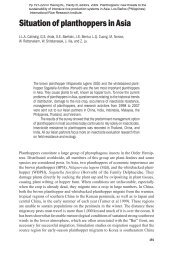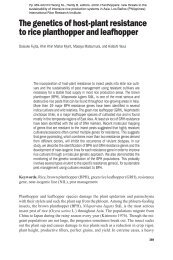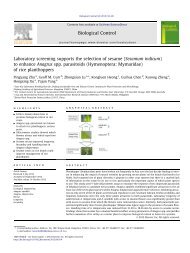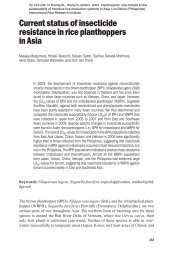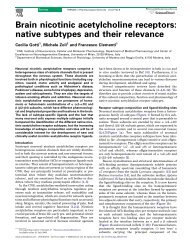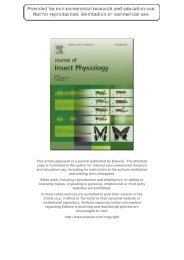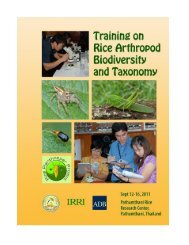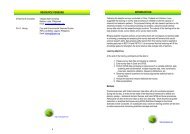Final Report Appendix 5 (Ho Chi Minh City Revised ... - Ricehoppers
Final Report Appendix 5 (Ho Chi Minh City Revised ... - Ricehoppers
Final Report Appendix 5 (Ho Chi Minh City Revised ... - Ricehoppers
Create successful ePaper yourself
Turn your PDF publications into a flip-book with our unique Google optimized e-Paper software.
We plan to seek additional funding to develop molecular (DNA ‘barcoding’) identification<br />
methods for natural enemies captured in this project so you will notice later sections specify<br />
use of 100% ethanol for specimen storage. This will maximize DNA quality and is especially<br />
important for samples collected by sweep net and for parasitoids reared from egg trap plants<br />
because these specimens can be placed immediately into preservative without any<br />
degradation.<br />
Sampling methods for key hypothesis<br />
H o : Implementing ecological engineering improves biological control of pests by enhancing<br />
biodiversity compared with farmer’s practices using insecticides (control).<br />
Testing this hypothesis will require staff at each of the four sites to collect data from their<br />
ecological engineering area and the farmer’s practices using insecticides (control) area in<br />
following manner.<br />
Sampling in the two areas should be with the same equipment, using the same staff and as far<br />
as possible on the same day and approximately the same time of the day so that any<br />
differences between the two experimental treatments is attributable to the treatments and not<br />
an artifact of sampling.<br />
The sampling methods outlined below should be used in the approximate centre of rice fields<br />
(i.e. at least 10m from the field margin) and near the rice bunds (i.e. about 1m from the<br />
bunds) and from 10 fields in the ecological engineering and 10 fields in the farmer practice<br />
with insecticide spray (control) areas. Sampling by different methods should not be done on<br />
the same point, which was sampled before using another method (refer to sampling lay out).<br />
If different varieties have been sown in each of these areas (or there is some other difference<br />
such as fertilizer use/ sowing date/ irrigation etc) then fields should be matched as far as<br />
possible so that there is a ‘like for like’ field in the ecological engineering and farmer practice<br />
with insecticide spray (control) areas.<br />
For 10 fields in the ecological engineering and 10 fields in farmer practice with insecticide<br />
spray (control) take sample at the seedling, tillering, booting and milking stages of rice<br />
growth (i.e. samples at each of the four major growth stages) (refer to the general rice growth<br />
stages illustrated below) using the following methods:<br />
Yellow sticky trap (three traps mounted on wooden stakes to be just above the crop<br />
canopy with 5 meters distance between traps installed at the center of the rice field<br />
and near the rice bund, collected after 24 hr). There will be one hundred twenty<br />
samples for each sampling period.<br />
Yellow pan trap (three traps mounted on stand at approximately the same height of<br />
vegetation or just below the canopy level with 5 meters distance between traps at the<br />
center of the rice field and near the rice bund, left in place for 24 hr). There will be<br />
one hundred twenty samples for each sampling period.<br />
Blower-vac sampler (single sample from an undisturbed part of the center of the field<br />
and near the rice bund). There will be forty samples for each sampling period.



